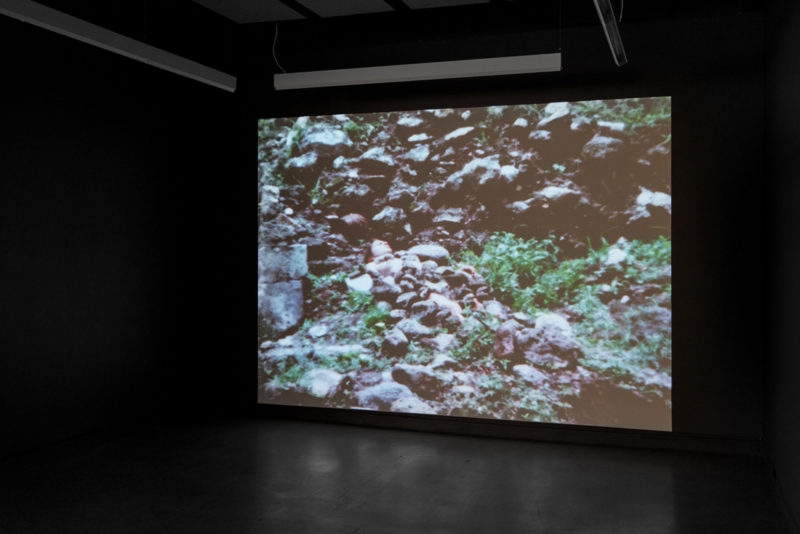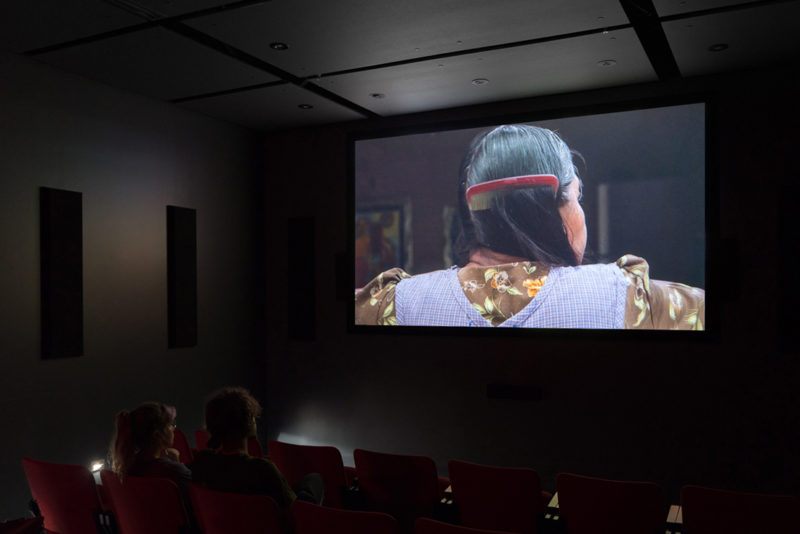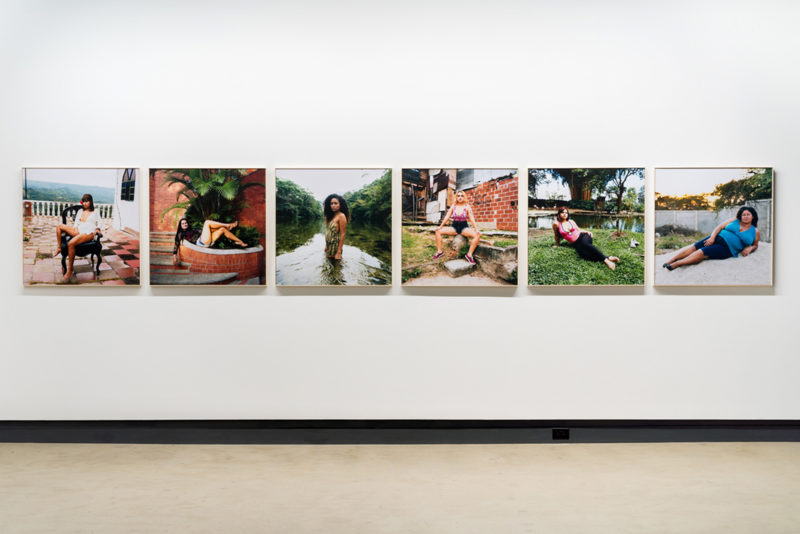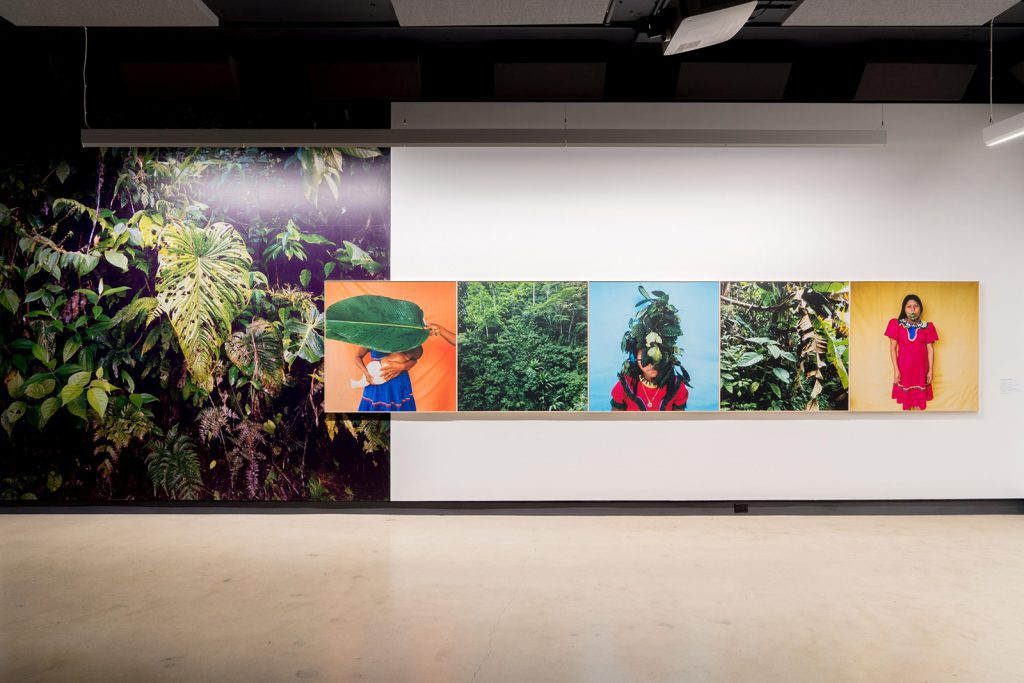Bending toward Liberation: ‘Libertad’ at Dazibao
24 June 2020
By Angel Callander
Ana Mendieta’s work embodied the complexities of nature, sovereignty, and taking up space. In Libertad, shown at Dazibao in Montréal from September 7 to October 19, 2019, French-Colombian artists Karen Paulina Biswell and Laura Huertas Millán appear alongside Mendieta to examine the sensual and material forces that impact the experiences of women, and the function of freedom for those who pass between being subjects and ‘objects.’ However, to limit this reading of the show within the confines of womanhood and female agency would be incomplete. Weaving through conceptions of home and belonging, and a determination for survival, the artists expose a slippage of race, nation, and gender that is inherent to all identity: concepts unable to be fixed within immovable categories. Together, the works comprise a criticism of the systems of knowledge that justify domination, as well as the essentializing gestures that equate women with nature.
To exhibit these two contemporary artists with Mendieta is to position them in a legacy she created, one that highlights the fugitive nature of female embodied experiences, both ancient and present, between nature and the colonized world. Beyond the mere surface representation of “woman,” Biswell and Huertas Millán focus on the intensity of experience, which impacts the social formation of identity and is brought to life through the material subjectivities of being a woman. Together these artists create a thoughtful portrait of rage and loss, beauty and domination, exile, community, and womanhood as fundamental parts of world-production through a Latin American lens, following a significant theme of curator María Wills Londoño’s projects.
As a young adolescent Mendieta was sent to the United States from Cuba with her sister, being political exiles by extension of their father’s activities as a counter-revolutionary. The personal and the social are often inextricable in her work, as she conceives of the broader conditions of loss, absence, and dislocation as embedded in womanhood, particularly for women of colour. Mendieta’s point of departure is the woman (and the female body) in exile. In her work, it is as though exile is a persistent condition of all life, expressed not through place or placement, but through that which is missing. Repeating the figure of the woman’s silhouette with legs joined together and arms raised, Mendieta emulates what is known in Spanish-speaking religious traditions as the ánima sola (the lonely, wandering soul in purgatory). Mendieta’s woman is not inherently bound to the earth. Rather, she exists at the borders of a liminal identity, craving some imagined home and community, some form of salvation.

The two works by Mendieta in the exhibition, Burial Pyramid (1974) and Alma, Silueta en Fuego (1975), are filmic impressions of the union of performance and earthwork. They exemplify turning the spectres of loss, displacement, and death into something present and palpable. The “Silueta” figure more broadly becomes a symbol of all those who have been oppressed by the machinations of the nation-state. Both films build to a crescendo, reveling in the processes of destruction and generation. Alma, Silueta en Fuego shows the burning of a cloth silhouette placed in the centre of a well of mud. The fire ignites seemingly on its own, engulfing the figure until it has burned entirely to ash. In Burial Pyramid, Mendieta herself is seemingly ‘buried alive’ beneath a pile of rocks. At first, the film appears to be a static image, but as Mendieta slowly inhales and exhales, her body moves with enough eventual force to remove the pile of rocks covering her.
This dual expression of entrapment and resuscitation becomes a metaphor for the burden of colonialism, where survival is based on the relief that comes through engagement with community. Both Biswell and Huertas Millán situate themselves in Mendieta’s legacy of acknowledging the mutually constituted symbiosis of humans and the natural world, while undermining the perspective of the colonizer and a Western system of dualistic reasoning, through their adept utilization of filmic and performative modes of making.
Huertas Millán’s film, Journey to a land otherwise known (2011) criticizes ethnographic knowledge on a more structural, political level. The notion of exoticism in the diaristic texts of colonizers such as Bernal Diaz del Castillo, Jean de Léry, and Hans Staden is defined against the ‘rationality’ and ‘neutrality’ of Western science, and is ultimately used to further justify the domination of the ‘Third World.’ The film’s visuals invoke the sensual aspects of the natural world, unassociated with science, centering the botanical ecosystem through slow tracking shots. There is a mysterious intimacy in these scenes, encouraging us to consider the evolution of this place in its own right, without people. This is not a ‘female’ nature, it is a standalone entity. Huertas Millán uses the artificial jungle inside the tropical greenhouse at the botanical garden in Lille, France—a heterotopic space within a space. By using a jungle housed in an architectural structure, Huertas Millán summons a particular history of colonial horticulture, as with the Wardian case, a proto-terrarium used to transport plants from colonies back to Europe for study in the 19th century, often forcing those from the Indigenous population to accompany them and assist in caring for the plants.
The voiceover of the film recites excerpts from texts by the aforementioned colonizers, relaying the discourse and rationale of hegemony, as told by those who do not respect non-scientific forms of knowledge and the collective responsibility they espouse, which stand in opposition to the logic of imperialism. As such, their writings and choice of language expose the shades of violence that is encoded in cross-cultural encounters, historically justifying the spread of a ‘civilized’ empire and industrialized society. Removed from their context and origins, phrases from Hans Staden’s “True Story and Description of a Country of Wild, Naked, Grim, Man-eating People in the New World” (1557) sound like the musings of racist conquistadors to us, knowing what we know now about the legacies of history’s imperial projects. Through undermining the once-heralded strength and heroism of European empire, Huertas Millán subverts the authoritative voice of the colonizer and presents the content of these texts as the propaganda of domination.

Conceptually resembling a film of ‘first contact’ by European missionaries, scientists, and ‘explorers,’ Journey to a land otherwise known bares a paradox of visual anthropology and ethnography, seeking to deconstruct and reinscribe its conventions. In interviews, Huertas Millán has discussed her affinity for anthropologist Jean Rouch’s concept of “ethnofiction,” which intends to blur the boundaries between documentary and fictional filmmaking. Rouch sought to create a more participatory approach to ethnographic film, resulting in a reflexive or shared anthropology in which those being filmed were asked for their input on how they would be portrayed. Pieces of ethnography are mixed with improvisation or decisive participation that blends reality and narrative structure in a collaborative effort between filmed subjects and the filmmaker.
Huertas Millán’s approach to postcolonial filmmaking makes experimental use of ethnofiction as a hybrid genre that defies strict categorization. Vietnamese filmmaker and theorist Trinh T. Minh-ha has frequently discussed hybridity and the burden of representation for non-European filmmakers. She expresses the difficulty anthropology as a discipline has with neatly packaging ethnographic knowledge to a Western audience. (1) In her film works, Huertas Millán enacts a pastiche of authenticity by fusing the ‘real’ of ethnography with elements and layers of critique as part of an alternative genre for truth. Authenticity is itself dialectical, seen at once as emanating from an inner character, and also as a narrative of originality from the past or the ‘old world.’ In anthropology, as in colonialism, the ambivalence of authenticity sways between the virtue and dignity of the individual, and the perceived naïve self-sufficiency of ‘primitive’ cultures and their ways of life. This serves as legitimization for their loss of worldly freedom, and necessitates oppression as that which brings out the truly authentic elements of life.
In the photographic series Ellas (2012-2017) and Nama Bu (2012-2014), Biswell portrays femininity through a diffracted lens of clichés about objectification, analyzing the fissures within the taxonomies of womanhood, race, and nationality. Each of these categories struggles individually with the concept of authenticity, often comprised of various intersecting moments of vulnerability and discomfort, both ephemeral and enduring. Biswell describes her own upbringing in Paris and Colombia as a constant transition between Western, Eurocentric cosmopolitanism and the nostalgia for a ‘lost paradise’ in South America. Structuring very different social apparatuses for desire, taboo, identification, and knowledge, each of these worlds is often seen as an opposing force to the other. For Biswell, however, both can and must exist simultaneously.

Her subjects in Ellas are ordinary women, but she casts them as icons of defiance that reject categorization as adhering to any one set of procedures for being. Biswell captures her subjects in portraits of contemporary life, with its attendant cultural filters for prohibition, intimacy, and female sexuality. The subjects’ attitude of self-determination reveals the complex, variegated expressions of identity and labels when applied to real people. The authenticity of vulnerability is set against the supposed authenticity of categorical thinking.
Nama Bu (meaning “we exist” in native Embera) consists of photos of a family from the Indigenous Colombian community of Emberá-Chamí. The particular dimensions of femininity, womanhood, and society defined in Indigenous terms add to the already complex, multivalent paradigms of these identifications. The schism between “inside” and “outside” that is implied within Indigenous communities is here taken up as a means of complicating this binary of relational opposites once again. As in Ellas, these women are photographed domestically, alone or with family members, interspersed with photos of their natural environments. Young girls with face and hand tattoos, breast-feeding mothers, embodying the contours of self-determination and the freedom in survival. Against the backdrop of a history of art from the Primitivist painting of Gauguin, there is no exoticism, no naïve idealization, and no conquest.
The broader motifs running through these works are the paradigms of difference, choice, and authenticity—effectively, modes of negotiating freedom. Authenticity and power are, like gender, often seen as structurally essentialized and interdependent facets of life. Each of these three artists contests these modes of essentialization in their own ways, pushing back on the universal and the monolithic. The fugitive nature of embodied experience refutes the notion that one’s primordial essence is tantamount to knowing one’s place.
In the words of Vietnamese filmmaker and theorist Trinh T. Minh-ha, “Difference does not annul identity. It is beyond and alongside identity.” (2) She explains that many women of colour feel they must make a choice between womanhood and ethnicity, but ultimately there can be no choice between the two since one never exists without the other. “How am I to lose, maintain, or gain an (fe/male) identity when it is impossible to me to take up a position outside this identity from which I presumably reach in and feel for it?” (3) What becomes evident when these works are seen in relation is not so much affinity—of womanhood, of ethnicity, or of the experience of colonial legacies—but a process of differentiation, bending towards liberation.
This process occurs not in speaking for and about, but in speaking nearby or together with. In other words, it works against the divide-and-conquer tactics of hegemony. This differentiation accounts for the elusive discursive elements that manage to exist alongside each other. The ability to undo all forms of suffering is expressed through compassion and liberation. A critical, deconstructing relation of self and other allows for the kind of dialectic that highlights difference as a given and not a force to be stamped out. It is first and foremost about acknowledging the complexity of all things in nature.
The work of Mendieta, Huertas Millán, and Biswell in Libertad opens up the possibility for these dialectics. Following in Trinh’s own conclusions through her work, these three artists engage with the notion that understanding the pervasiveness of hegemony and domination towards decolonization should be done from within women’s movements, inserting themselves in that conversation. Engaging with the hybrid, heterogeneous nature of societies, and the various (racial, natural, cultural, sexual) actors they consist of, should establish an alternative to binary thinking. Systems of dualistic reasoning have been put in place to benefit oppressive projects like colonialism, whereas the naturally ambivalent experiences of identity allow for forms of relating that are more fluid and alive.
What Trinh refers to as a “shifting multi-place of resistance” is an alternative to the divide-and-conquer method of identity politics. Rather than thriving on opposition and constraint, the works in Libertad allow for a more decentralized view of identity and collectivity through this shifting multi-place. Each artist demonstrates their unique method for exploring both the elusive and the material aspects of being as inseparable, not just on an aesthetic level, but also as they impact lived experience. The ancient and the modern, the universal and the particular, all converge in a complex arrangement of self and other, human and nonhuman, intimate and infinite. Only through these methods will we come to better understand each other and ourselves within various histories of dislocation and alienation.
1. See: Trinh T. Minh-ha, Cinema-Interval (Routledge, 1999), also Nancy N. Chen, “‘Speaking Nearby:’ A Conversation with Trinh T. Minh-ha,” Visual Anthropology Review 8:1 (1992), https://docfilmhist.files.wordpress.com/2008/09/chen.pdf
2. Trinh T. Minh-ha, Woman, Native, Other: Writing Postcoloniality and Feminism (Indiana University Press, 1989): 104.
3. Ibid., 95.
Libertad ran from September 7 to October 19, 2019 at Dazibao in Montréal, QC.
Feature Image: Nama Bu series, 2012-2014 by Karen Paulina Biswell. Photo by Jean-Michael Seminaro courtesy of Dazibao.



